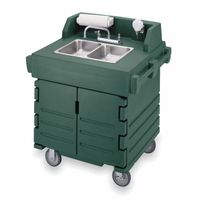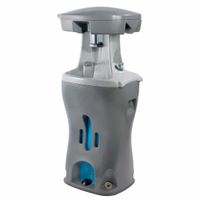Call +(254) 703 030 000 / 751 483 999 / 721 704 777
- Home
- Plumbing
- Sinks Wash Fountains Repair Parts
- Portable Hand Sinks Hand Wash Stations
Frequently Asked Questions
What are the benefits of using portable hand sinks and hand wash stations?
Portable hand sinks and hand wash stations offer numerous benefits, particularly in environments where traditional plumbing is unavailable or impractical. They enhance hygiene by providing immediate access to handwashing facilities, crucial for preventing the spread of germs and maintaining public health. This is especially important in outdoor events, construction sites, and remote locations.
These units are highly versatile and can be easily relocated to meet changing needs, making them ideal for temporary setups like festivals, fairs, and disaster relief operations. Their mobility ensures that handwashing facilities are always within reach, promoting consistent hygiene practices.
Portable hand sinks are often self-contained, requiring no external plumbing or electrical connections. This feature allows for quick and easy installation, reducing setup time and costs. Many models come with foot pumps or battery-operated systems, ensuring they remain functional even in areas without power.
The design of portable hand wash stations often includes features like soap dispensers, paper towel holders, and waste receptacles, providing a comprehensive hand hygiene solution. This all-in-one approach encourages proper handwashing techniques by making all necessary supplies readily available.
In addition to their practical benefits, portable hand sinks can be a cost-effective solution for businesses and organizations. They eliminate the need for expensive plumbing installations and can be rented or purchased based on specific needs, offering financial flexibility.
Overall, portable hand sinks and hand wash stations are essential tools for maintaining hygiene in diverse settings, offering convenience, flexibility, and cost-effectiveness while supporting public health initiatives.
How do portable hand sinks and hand wash stations work?
Portable hand sinks and hand wash stations are self-contained units designed to provide handwashing facilities in locations where traditional plumbing is unavailable. They operate using a combination of water storage, pumps, and waste collection systems.
These units typically consist of a fresh water tank and a waste water tank. The fresh water tank holds clean water, which is dispensed through a faucet. The faucet can be operated manually via a foot pump, hand pump, or automatically with a sensor. The foot or hand pump mechanism involves a pedal or lever that, when pressed, activates a pump to draw water from the fresh water tank to the faucet. Sensor-operated faucets use battery-powered sensors to detect hand presence and automatically release water.
The waste water tank collects used water, ensuring it does not contaminate the surrounding area. This tank is usually larger than the fresh water tank to accommodate additional volume from soap and handwashing. Both tanks are designed for easy removal and cleaning.
Portable hand sinks often include soap dispensers and paper towel holders, providing a complete hand hygiene solution. They are constructed from durable materials like stainless steel or heavy-duty plastic to withstand outdoor conditions and frequent use.
These units are commonly used in outdoor events, construction sites, food service areas, and emergency situations. They ensure compliance with health regulations by providing necessary handwashing facilities, thus promoting hygiene and preventing the spread of germs. Regular maintenance involves refilling the fresh water tank, emptying the waste water tank, and replenishing soap and paper towels.
What are the differences between self-contained and external supply models?
Self-contained and external supply models are two distinct approaches to managing resources and operations within an organization.
A self-contained supply model involves an organization managing its entire supply chain internally. This means that all processes, from procurement of raw materials to production and distribution, are handled within the company. The primary advantage of this model is greater control over the supply chain, which can lead to improved quality, consistency, and responsiveness to changes in demand. It also allows for better protection of proprietary processes and technologies. However, it requires significant investment in infrastructure, technology, and human resources, and can lead to higher operational costs.
In contrast, an external supply model relies on third-party suppliers and partners to manage parts of the supply chain. This model allows companies to leverage the expertise and efficiencies of specialized suppliers, potentially reducing costs and increasing flexibility. It enables organizations to focus on core competencies while outsourcing non-core activities. The external supply model can also facilitate scalability and faster entry into new markets. However, it may result in less control over the supply chain, increased dependency on suppliers, and potential risks related to supply chain disruptions or quality issues.
In summary, the self-contained model offers control and integration at the cost of higher investment and complexity, while the external supply model provides flexibility and cost savings with potential risks related to dependency and control. Organizations often choose a hybrid approach, balancing internal capabilities with strategic partnerships to optimize their supply chain management.
How do you maintain and clean portable hand sinks and hand wash stations?
To maintain and clean portable hand sinks and hand wash stations, follow these steps:
1. **Daily Inspection**: Check for leaks, damage, or malfunctions. Ensure all parts, including faucets and soap dispensers, are operational.
2. **Empty Wastewater**: Regularly empty the wastewater tank to prevent overflow and odors. Follow local regulations for proper disposal.
3. **Refill Fresh Water**: Refill the fresh water tank with clean, potable water. Use a hose or container that is specifically designated for this purpose to avoid contamination.
4. **Clean Surfaces**: Use a non-abrasive cleaner and a soft cloth or sponge to clean all surfaces, including the basin, faucet, and handles. Pay special attention to high-touch areas.
5. **Sanitize**: Apply a food-safe sanitizer to all surfaces after cleaning. Allow it to air dry or follow the manufacturer's instructions for contact time.
6. **Check Soap and Sanitizer Levels**: Refill soap and hand sanitizer dispensers as needed. Use products that are effective against a broad spectrum of pathogens.
7. **Inspect and Clean Drains**: Ensure drains are clear of debris. Use a mild detergent and water to clean the drain area.
8. **Check Paper Towel Dispensers**: Refill paper towel dispensers and ensure they are functioning properly.
9. **Regular Deep Cleaning**: Schedule regular deep cleaning sessions. Disassemble parts if necessary and clean thoroughly to prevent buildup of grime and bacteria.
10. **Record Maintenance**: Keep a log of maintenance and cleaning activities to ensure regular upkeep and compliance with health regulations.
11. **Training**: Ensure staff are trained in proper cleaning and maintenance procedures to maintain hygiene standards.
By following these steps, you can ensure that portable hand sinks and hand wash stations remain clean, functional, and hygienic.
Are portable hand sinks and hand wash stations suitable for outdoor events?
Yes, portable hand sinks and hand wash stations are suitable for outdoor events. They provide essential hygiene facilities, ensuring attendees can maintain cleanliness, which is crucial for health and safety. These units are designed to be easily transported and set up, making them ideal for temporary locations. They often come with features like foot pumps or sensor-activated faucets, which minimize contact and reduce the spread of germs. Additionally, they are equipped with soap dispensers and paper towel holders, offering a complete handwashing solution.
Portable hand wash stations are versatile and can be placed strategically around event areas, such as near food stalls, restrooms, and entrances, to encourage frequent handwashing. This accessibility helps in promoting good hygiene practices among attendees. They are also available in various sizes and capacities, catering to different event scales, from small gatherings to large festivals.
Moreover, these stations are designed to be durable and weather-resistant, ensuring they function effectively in various outdoor conditions. They often have large water tanks and waste reservoirs, allowing for extended use without frequent maintenance. Some models are even equipped with water heaters, providing warm water for enhanced comfort and cleaning efficiency.
In summary, portable hand sinks and hand wash stations are practical, efficient, and essential for maintaining hygiene at outdoor events, contributing to the overall health and safety of participants.
What features should I look for in a portable hand sink or hand wash station?
When selecting a portable hand sink or hand wash station, consider the following features:
1. **Portability**: Look for lightweight designs with wheels or handles for easy transport.
2. **Size and Capacity**: Ensure the sink has adequate water and waste capacity for your needs, typically measured in gallons.
3. **Material**: Choose durable materials like stainless steel or high-density polyethylene for longevity and ease of cleaning.
4. **Water Source**: Decide between self-contained units with built-in tanks or those requiring external water connections.
5. **Power Source**: Consider whether the unit is manual, battery-operated, or requires an electrical connection for pumps and heaters.
6. **Water Heating**: If warm water is necessary, ensure the unit has a built-in heater or can connect to a hot water source.
7. **Number of Basins**: Depending on usage, you may need multiple basins for handwashing, rinsing, and sanitizing.
8. **Soap and Towel Dispensers**: Integrated dispensers for soap and paper towels enhance convenience and hygiene.
9. **Foot Pump Operation**: Hands-free operation via foot pumps can improve hygiene by reducing touchpoints.
10. **Drainage System**: Check for efficient waste water disposal, either through a built-in tank or external drainage.
11. **Compliance**: Ensure the unit meets local health and safety regulations, especially for food service or medical use.
12. **Ease of Maintenance**: Look for easy access to tanks and components for cleaning and refilling.
13. **Stability and Durability**: Ensure the unit is stable and can withstand frequent use and movement.
14. **Cost**: Balance features with budget, considering both initial purchase price and long-term maintenance costs.
15. **Brand Reputation and Warranty**: Choose reputable brands offering warranties for added assurance.
How much do portable hand sinks and hand wash stations typically cost?
Portable hand sinks and hand wash stations typically range in price based on their features, materials, and intended use. Basic models, often made of lightweight plastic and designed for temporary or occasional use, can start at around $100 to $300. These are usually simple units with a manual pump for water and a small basin.
Mid-range options, which may include features like foot pumps, larger basins, and more durable materials such as stainless steel, generally cost between $300 and $800. These are suitable for more frequent use and can be found in settings like outdoor events or construction sites.
High-end portable hand wash stations, which might include advanced features such as hot water capability, multiple basins, and built-in soap and towel dispensers, can range from $800 to over $2,000. These are often used in commercial settings where hygiene standards are critical, such as food service or healthcare environments.
Additional costs may include accessories like water heaters, extra tanks, or custom branding, which can increase the overall price. Delivery and installation fees might also apply, depending on the supplier and location.
Renting is another option, with prices typically ranging from $50 to $150 per day, depending on the unit's features and the rental duration. This can be a cost-effective solution for short-term needs, such as events or temporary work sites.
Overall, the cost of portable hand sinks and hand wash stations varies widely, and the choice depends on the specific requirements of the user, including the frequency of use, the environment, and the desired features.

